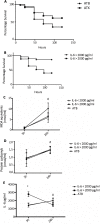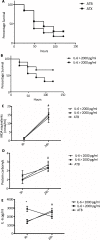Stratification to predict the response to antioxidant
- PMID: 32401970
- PMCID: PMC7206955
- DOI: 10.5935/0103-507x.20200016
Stratification to predict the response to antioxidant
Abstract
Objective: To examine the effectiveness of stratification to identify and target antioxidant therapy for animal models of lethal sepsis and in patients who develop sustained hypotension.
Methods: Rats were subjected to sepsis induced by cecal ligation and puncture. Animals were divided into two groups: those with high and low plasma levels of interleukin-6. Following stratification, N-acetylcysteine plus deferoxamine or saline was administered to animals starting 3 and 12 hours after surgery. N-Acetylcysteine plus deferoxamine or placebo was administered within 12 hours of meeting the inclusion criteria in hypotensive patients.
Results: N-Acetylcysteine plus deferoxamine increased survival in the cecal ligation and puncture model when administered 3 and 12 hours after sepsis induction. When dividing animals that received antioxidants using plasma interleukin-6 levels, the protective effect was observed only in those animals with high IL-6 levels. The antioxidant effect of N-acetylcysteine + deferoxamine was similar in the two groups, but a significant decrease in plasma interleukin-6 levels was observed in the high-interleukin-6-level group. Compared with patients treated with antioxidants in the low-interleukin-6 subgroup, those in the high-interleukin-6 subgroup had a lower incidence of acute kidney injury but were not different in terms of acute kidney injury severity or intensive care unit mortality.
Conclusion: Targeting antioxidant therapy to a high inflammatory phenotype would select a responsive population.
Objetivo: Avaliar a efetividade da estratificação para identificar e escolher alvos para terapia antioxidante em um modelo de sepse letal em animais e pacientes que desenvolveram hipotensão prolongada.
Métodos: Submeteu-se um grupo de ratos à sepse induzida por ligadura e punção do ceco. Os animais foram divididos em dois grupos: os com níveis plasmáticos altos e os com níveis plasmáticos baixos de interleucina-6. Após a estratificação, administrou-se aos animais N-acetilcisteína mais desferroxamina ou soro fisiológico a partir de 3 e 12 horas após a cirurgia. Em pacientes hipotensos, N-acetilcisteína mais desferroxamina ou placebo foram administrados dentro de 12 horas após o cumprimento dos critérios para inclusão.
Resultados: O uso de N-acetilcisteína mais desferroxamina aumentou a sobrevivência no modelo com ligadura mais punção do ceco quando a administração ocorreu 3 e 12 horas após indução da sepse. Ao utilizar os níveis de interleucina-6 para separar os animais que receberam antioxidantes, o efeito protetor só foi observado nos animais que tinham níveis elevados de interleucina-6. O efeito antioxidante de N-acetilcisteína mais desferroxamina foi similar nos dois grupos, porém observou-se diminuição significante dos níveis plasmáticos de interleucina-6 no grupo que apresentava elevado nível de interleucina-6. Em comparação com pacientes tratados com antioxidantes no subgrupo que tinha baixos níveis plasmáticos de interleucina-6, aqueles que tinham níveis elevados de interleucina-6 tiveram menor incidência de lesão renal aguda, porém não foram diferentes em termos de severidade da lesão renal aguda ou da mortalidade na unidade de terapia intensiva.
Conclusão: Direcionar a terapia antioxidante para um elevado fenótipo inflamatório selecionaria uma população responsiva.
Conflict of interest statement
Figures



References
-
- Perner A, Gordon AC, Angus DC, Lamontagne F, Machado F, Russell JA, et al. The intensive care medicine research agenda on septic shock. Intensive Care Med. 2017;43(9):1294–1305. - PubMed
-
- Osuchowski MF, Welch K, Siddiqui J, Remick DG. Circulating cytokine/inhibitor profiles reshape the understanding of the SIRS/CARS continuum in sepsis and predict mortality. J Immunol. 2006;177(3):1967–1974. - PubMed
-
- Remick DG. Cytokine therapeutics for the treatment of sepsis: why has nothing worked? Curr Pharm Des. 2003;9(1):75–82. - PubMed
MeSH terms
Substances
LinkOut - more resources
Full Text Sources
Medical

